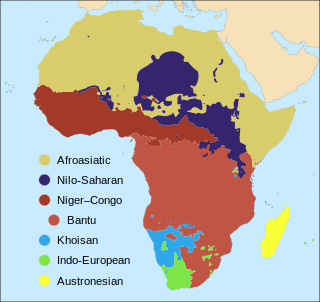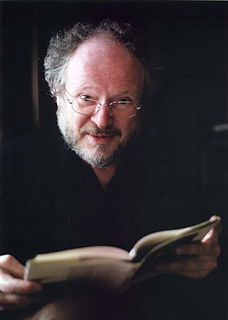Related Research Articles

Nostratic is a controversial hypothetical macrofamily, which includes many of the indigenous language families of Eurasia, although its exact composition and structure vary among proponents. It typically comprises Kartvelian, Indo-European and Uralic languages; some languages from the similarly controversial disputed Altaic family; the Afroasiatic languages spoken in North Africa, the Horn of Africa, the Arabian Peninsula and the Near East as well as the Dravidian languages of the Indian Subcontinent.

A creole language, or simply creole, is a stable natural language that develops from the simplifying and mixing of different languages into a new one within a fairly brief period of time: often, a pidgin evolved into a full-fledged language. While the concept is similar to that of a mixed or hybrid language, creoles are often characterized by a tendency to systematize their inherited grammar. Like any language, creoles are characterized by a consistent system of grammar, possess large stable vocabularies, and are acquired by children as their native language. These three features distinguish a creole language from a pidgin. Creolistics, or creology, is the study of creole languages and, as such, is a subfield of linguistics. Someone who engages in this study is called a creolist.

The languages of Africa are divided into several major language families:
In linguistics, a stratum or strate is a language that influences or is influenced by another through contact. A substratum or substrate is a language that has lower power or prestige than another, while a superstratum or superstrate is the language that has higher power or prestige. Both substratum and superstratum languages influence each other, but in different ways. An adstratum or adstrate is a language that is in contact with another language in a neighbor population without having identifiably higher or lower prestige. The notion of "strata" was first developed by the Italian linguist Graziadio Isaia Ascoli (1829–1907), and became known in the English-speaking world through the work of two different authors in 1932.
Language contact occurs when speakers of two or more languages or varieties interact and influence each other. The study of language contact is called contact linguistics. When speakers of different languages interact closely, it is typical for their languages to influence each other. Language contact can occur at language borders, between adstratum languages, or as the result of migration, with an intrusive language acting as either a superstratum or a substratum.
A mixed language is a language that arises among a bilingual group combining aspects of two or more languages but not clearly deriving primarily from any single language. It differs from a creole or pidgin language in that, whereas creoles/pidgins arise where speakers of many languages acquire a common language, a mixed language typically arises in a population that is fluent in both of the source languages.
Two languages have a genetic relationship, and belong to the same language family, if both are descended from a common ancestor, or one is descended from the other. The term and the process of language evolution are independent of, and not reliant on, the terminology, understanding and theories related to biological genetics, and to avoid confusion, some linguists propose to replace this term with genealogical relationship

Sarah Grey Thomason is an American scholar of linguistics. She is a prolific contributor to academic journals and publications specializing in the field of linguistics, as well as a guest lecturer at different universities around the world and a speaker at international conferences. She was named the William J. Gedney Collegiate Professor of Linguistics at the University of Michigan in 1999, and received the highest honor granted by the University of Michigan to its faculty by being named the Bernard Bloch Distinguished University Professor of Linguistics in 2016. She was also Chair of the Department of Linguistics from 2010 to 2013. She is currently an associate editor for the Journal of Historical Linguistics, as well as part of the advisory board of the Journal of Language Contact.

French Studies is a quarterly peer-reviewed academic journal published by Oxford University Press on behalf of the Society for French Studies. It was established in 1947 and covers all periods of French and francophone literature and culture. Articles are published in English or French. The journal is accompanied by a sister publication for shorter articles called The French Studies Bulletin.

Natural Language & Linguistic Theory is a quarterly peer-reviewed academic journal covering theoretical and generative linguistics. It was established in 1983 and originally published by Kluwer Academic Publishers. Since 2004 the journal is published by Springer Science+Business Media. The editor-in-chief is Julie Anne Legate.
The Bulletin de la Société de Linguistique de Paris is an academic journal published by the Société de Linguistique de Paris since 1869.

Henri Wittmann is a Canadian linguist from Quebec. He is best known for his work on Quebec French.
Linguistics is the scientific study of human language. It entails a comprehensive, systematic, objective, and precise analysis of all aspects of language, particularly its nature and structure. As linguistics is concerned with both the cognitive and social aspects of language, it is considered a scientific field as well as an academic discipline; it has been classified as a social science, natural science, cognitive science, or part of the humanities.
The Indo-Semitic hypothesis maintains that a genetic relationship exists between Indo-European and Semitic and that the Indo-European and the Semitic language families descend from a prehistoric language ancestral to them both. The theory has never been widely accepted by contemporary linguists in modern times, but historically it has had a number of supporting advocates and arguments, particularly in the 19th and 20th centuries.

Languages in Contrast is a peer-reviewed academic journal of contrastive linguistics established in 1998 and published biannually by John Benjamins Publishing Company. Focusing on comparative studies of two or multiple languages, it covers all subfields of both theoretical and applied linguistics, such as morphology, phonology, discourse analysis, language education, etc.

Lingvisticae Investigationes: International Journal of Linguistics and Language Resources is a peer-reviewed academic journal of linguistics published by John Benjamins Publishing Company. It publishes articles, book reviews, and summaries of PhD theses. The founding editor-in-chief was Maurice Gross (1977–2001). Former editors include Annibale Elia, Gaston Gross, Christian Leclère, and Elisabete Ranchhod.
Glottolog is a bibliographic database of the world's lesser-known languages, developed and maintained first at the Max Planck Institute for Evolutionary Anthropology in Leipzig, Germany. Its main curators include Harald Hammarström and Martin Haspelmath.
The Atlas of Pidgin and Creole Language Structures (APiCS) is a comparative linguistic atlas of contact languages. It exists as a four volume publication and online database in the form of a website APiCS Online.
Acta Orientalia Academiae Scientiarum Hungaricae is a quarterly peer-reviewed academic journal published by Akadémiai Kiadó. It covers oriental studies, including Turkic, Mongolian, Manchu-Tungusian, Chinese, Japanese, Tibetan, Indian, Iranian and Semitic philology, linguistics, literature, and history of the pre-modern era. It was established in 1950. The editor-in-chief is Gábor Kósa.
Alan Stewart Kaye (1944-2007) was an American linguist and professor at California State University, Fullerton. He is best known for his works on Semitic and other language families. He died of cancer on May 31, 2007.
References
- ↑ "Linguistic Bibliography Online". JISC Collections.
- 1 2 3 4 5 "Linguistic Bibliography". Brill.
- ↑ "Linguistic Bibliography Online from Brill". Virginia Tech. Archived from the original on 2017-07-25. Retrieved 2014-11-01.